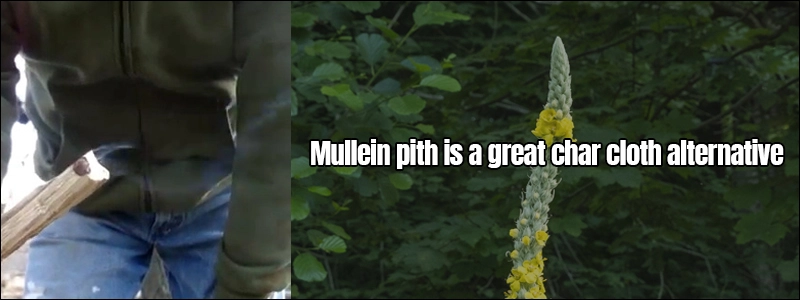Char cloth is a great fire starting aid. Having gone through the pyrolysis process, it’s very easy to ignite even with a low ignition temperature. This is why it’s so popular among those who enjoy starting fires with a flint and steel.
But what are some good alternatives to char cloth that can do just as good of a job? The best char cloth alternatives are; Tinder fungus, punk wood, milkweed pod, mullein pith and steel wool.
Let’s take a deeper look into each one.
Best char cloth alternatives
In the days when flint and steel was a highly depended on way of getting a fire going rather than the hobby it’s become today, cotton cloth and other fabrics used to make char cloth were a very valuable commodity.
People wouldn’t just take it and burn it to create char cloth as we know it today. No, they used these substitutes for char cloth. Mainly in the form of natural tinder.
1. Tinder Fungus
People tend to think there is only one type of tinder fungus, which isn’t true, let’s dive in.
Chaga
Tinder fungus is an excellent natural tinder that will take a spark fairly easily. My personal favorite tinder fungus and the one I have had the most success with is Chaga (Inonotus obliquus).
If you find yourself in a part of the world which is lush with birch trees, you shouldn’t have much trouble finding chaga.
Although more rare, chaga can also be found on the following trees:
- Alder
- Beech
- Ash
- Elm
Chaga is a fungus which grows off of the back of birch trees in colder climates. Not only does Chaga make a great tea, it’s an excellent natural tinder.
Keep in mind, once you harvest the chaga it will need to go through the process of drying out for a few hours before use.
The inside of the Chaga, which has a cork like look to it, is the part of the fungus you want to use to catch a spark.
Of course, you can char the chaga just like you would a piece of char cloth, and it will catch a spark that will turn into a very difficult to put out ember.
However, if you don’t want to take the time to process and char the chaga you can also use it raw.
You can break off a small piece of chaga to work with, but what I like to do is to use my knife to create a fine powder that can more easily catch a spark.
Scrape the chaga with your knife into a tin or tinder nest you have ready to go so that you are creating a nice fine pile of chaga dust. Keep going until you have a nice size pile.
Now all that’s left in the process is to use whichever spark making device you have with you, whether that be flint and steel or a flint rod, and start sending some sparks into the pile of chaga you just created.
Within no time at all, a spark will catch. Sometimes all it takes is a single spark.
Once a spark catches, it will quickly spread and engulf the rest of the chaga powder you’ve created, so be sure to transfer it to your tinder bundle.
Fun tip: If you don’t have a device that can create a spark, you can get an ember going in the chaga by harnessing the sun, whether that be using a pair of glasses, bottle, magnifying glass etc.
Horse hoof Fungus
Horse hoof fungus (Fomes fomentarius), which is also often referred to as Hoof Fungus can primarily be found growing on birch trees, however it can also be found on beech, birch and oak trees. Like chaga, it is also a great natural tinder.
Although horse hoof fungus can be used to catch a spark just like char cloth and chaga, it does require a little more preparedness as it’s a much longer process.
Unlike Chaga, it is not the complete inside of the hoof fungus that you are going to be able to use to catch a spark, rather, it’s the small layer between the outer shell and the inner shell which can be processed and used to catch your spark.
Once you have the fungus processed, it isn’t just yet ready to ignite. First you will need to soak it, you can soak it in a pot of water and ash from your fire, preferably birch ash. Do this for about an hour.
Once it’s done soaking, it should be relatively soft and will be ready for boiling. The longer, the better, but you can take the pieces out to let them cool down after an hour or so.
Next, you want to hammer down all the pieces. Not too hard, sort of let the weight of your hammer or axe head fall down on it. This will help it dry out quicker, as well as break up the natural fiber, allowing it to take a spark much better.
Once done, let it sit to dry for a day or two and it will be ready to go.
Check out this great video explaining how to properly process horse hoof fungus.
2. Punk wood
If you’re in the part of the world where tinder fungus isn’t available, a great substitute for char cloth for you would be punk wood. Punk wood can be found anywhere that there are trees.
It’s preferred that you use punk wood from a hardwood tree, as they tend to carry a coal better. Maple, for example.
For those of you who don’t know what punk wood is, it’s essentially rotten wood, typically caused by a fungal infection within the tree.
The best punk wood for the job will feel almost sponge like.
Now, whether freshly harvested or if it’s gone through the charring process, punk wood can be used to catch a spark. Obviously, the charred version will catch a spark more easily and have a longer burn time.
Take a look at this great video that will explain to you exactly how to make charred punk wood as a char cloth alternative.
3. Milkweed pod
Another natural alternative to char cloth is Milkweed pod.
What we want to harvest in order to catch a spark is the fluffy like material on the inside of the pod, commonly referred to as milkweed ovum.
They are the easiest to spot after summer into the fall when the pods have already opened up and released all the seeds.
Unlike punk wood and tinder fungus, the milkweed ovum has a very short burn time, so once it catches a spark you want to transfer it to your tinder nest as soon as possible.
The milkweed ovum is highly combustible and is able to ignite with a low ignition heat spark that comes with flint and steel. Without being charred.
4. Mullein pith
Mullein pith has been a staple alternative to char cloth for hundreds of years. It’s easy to find, and it doesn’t need to be charred to catch a spark.
Mullein is a tall, slender plant with yellow flowers. The pith which is what you will be using to catch your spark is the sponge like material found on the inside of the stalk of a mullein plant.
In order to give yourself the best chance to catch a spark with Mullein pith, you should be sure to slice it super thin.
5. Steel Wool
Far from the natural char cloth alternatives we’ve been talking about thus far, steel wool works just as well, if not better.
The thing is, there is no steel tree in the wilderness that produces steel wool, nor a steel sheep. You have to bring it from home, and if you are going out of your way to bring steel wool from home…you may as well bring a lighter.
That said, it does indeed catch a spark very well and will get a fire going for you in no time.
The benefits of char cloth
Char cloth (typically made from cotton cloth) is widely used not just for its ability to catch a weak spark from something like flint and steel, but rather it’s reliability in doing so.
Char cloth will often only require a single spark to get going.
On top of that, it’s a virtually windproof method of getting a fire going. In fact, wind can potentially aid in the process of starting a fire with char cloth.
Although we just went through a variety of char cloth substitutes, it’s hard to find an alternative (especially in nature) that can catch a very weak spark with a low ignition temperature.
Sure, they will all get the job done for you no problem, but most of the time char cloth will take less time.
How long does char cloth last?
Provided the char cloth is stored in a dry space, char cloth can last indefinitely and has no shelf life. Do not store char cloth anywhere it can become humid or damp, like a basement.
Tip: If you throw some desiccant packs in the tin or whatever you are using to store your char cloth, it can help draw all moisture away from the chart cloth, further extending its usability.
Was this post helpful?

Hey I’m Josh! I have been practicing Bushcraft for a little over 6 years now! I Started this website to review awesome bushcraft gear that I love as well as share information I have learned along the way!



